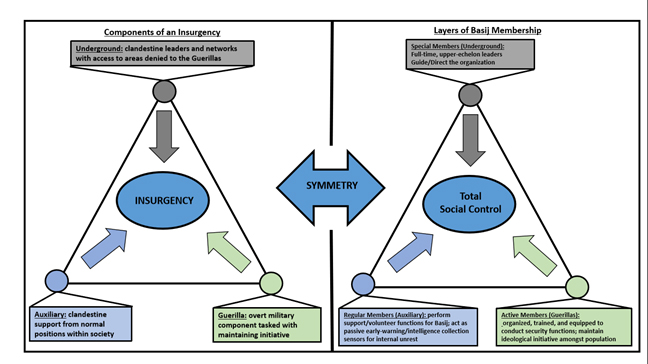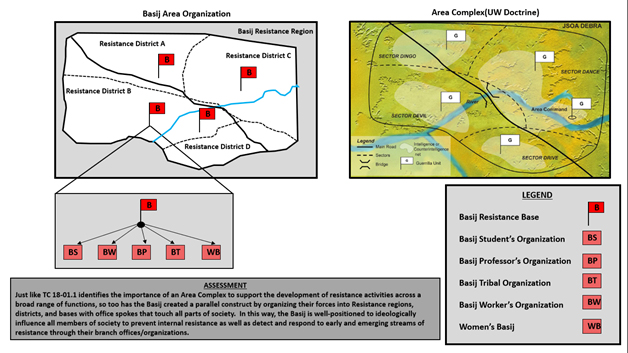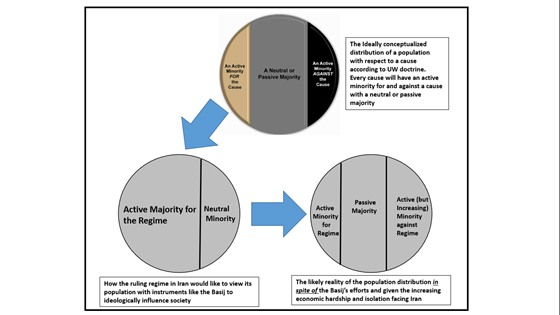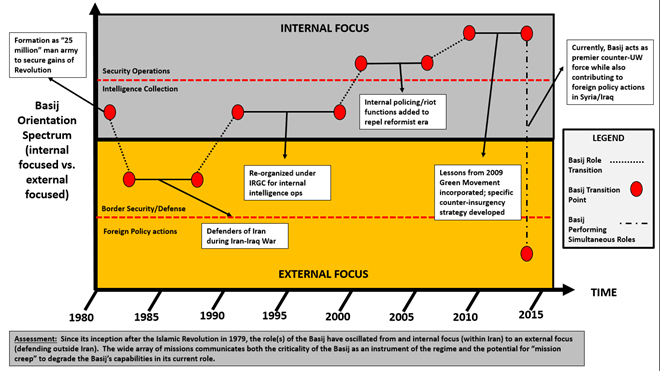Scott J. Harr
The use of irregular resistance forces to overthrow a government encapsulates major elements of the current United States Special Operations Command (USSOCOM) definition of Unconventional Warfare (UW). In this context, activities such as coup d’états and populist revolutions that lead to the ouster of established governments represent successful applications of UW campaigns. While political sensitivities often limit the desired goal for US-sponsored UW campaigns to the lesser of its defined end-states (coercion and disruption), the ability to alter and influence the direction of national governments with limited (or no) use of conventional military capabilities makes UW both attractive to those looking for “low cost” regime change options as well as dangerous to those regimes plagued by ungoverned spaces, internal unrest, and/or lack of confidence from their populations. Perhaps no country understands this better in modern times than Iran. Starting with the Western-led coup d’état against its prime minister in 1953 and continuing through the Islamic Revolution in 1979, Iran’s current ruling elite have been both victims and perpetrators of successful UW campaigns. Bluntly, Iran understands UW – both how to conduct it and, critically, how to defend against it.
Given its extensive and (relatively) recent experiences with “activities conducted…to overthrow a government” (as doctrine describes UW), it should not be surprising that Iran, since the Islamic Revolution in 1979, has prioritized and dedicated significant resources to protecting the ruling regime from UW threats from within while (leveraging its empirically won UW principles) projecting highly capable UW forces abroad. After the 1979 Islamic Revolution in Iran, Ayatollah Khomeini wasted little time building the forces and organizations to protect his regime from UW threats as he created The Basij– a civilian militia and mass member organization that operationalized the ayatollah’s vision of a “20 million man” army to protect and secure the revolutionary ideology serving as the basis for the new Islamic Republic of Iran (Golkar, 2012). Unlike militias in the US, which sprung from a desire to protect the people from government overreach and as such often conjure up images of anti-government activities, The Basij, as noted by scholar Saeid Golkar, describes a pro-government militia (PGM) that exists to support the ruling Islamic regime. Its responsibilities (while ever-changing since its inception) cover a wide range of functions including internal security, policing, and the administering of public services all while propagating revolutionary ideology to the Iranian public at large. With branches and establishments in all sectors and strata of Iran and current membership perhaps reaching over 25 million Iranians, the Basij effectively penetrate Iranian civil society while acting as the regime’s front-line sensors detecting any hint of unrest and arresting the development of meaningful resistance against the regime. In this sense, the Basij remain the theocratic regime’s weapon of choice in its counter-UW efforts against its own population.
Given the above, the intent of this article is to show how the Iranian regime purposefully designed and deliberately structured the Basij to be its premier counter-UW force protecting the regime from the very actions it leveraged to ascend to power in 1979. Juxtaposing current UW doctrine with the Basij reveals reciprocal (or “Dark Side”) attributes of UW applications that the Basij use to dampen the prospects of internal resistance and thwart opportunities for successful UW against the regime. Additionally, the article will demonstrate that even as the Basij apply “Dark Side” concepts of UW doctrine to protect against UW in Iran, they are not a foolproof organization and the very mechanisms and characteristics that tend to make them successful can also introduce vulnerabilities ripe for exploitation.
The Dark Side of UW Doctrine
Every good superhero canon requires that the hero have an equally talented nemesis (the anti-hero) who, instead of using his/her powers for good, twists the application of the talents to work for evil. Likewise, UW doctrine has a dark side that can be twisted to not just prevent the liberation of oppressed peoples (“de oppresso liber”- to free the oppressed- the motto of the US Army’s Special Forces), but actually oppress a people desiring to be free. When considering how the Basij exploit the dark side of UW doctrine, it is useful to begin by examining the basic doctrinal elements of an insurgency.
According to UW doctrine, insurgencies utilize three main elements to accomplish their activities subverting and/or overthrowing a government: the auxiliary, the guerillas, and the underground. The auxiliary represent members of the insurgency who provide passive (and clandestine) support utilizing their everyday roles in society. These “part-time volunteers” perform a number of support functions for the UW movement including logistics, security/early-warning, and intelligence collection all while never departing or deviating from their normal lives. Next, there are the guerillas who represent the overt military component of the insurgency. As such, the guerillas must forge and maintain a connection to the local population in order to “maintain the initiative” (which represents their single advantage over the government in power) recruiting personnel and prosecuting operations in the UW campaign. Finally, the underground component represents the clandestine leaders of the insurgency who, besides often directing and controlling the direction of the insurgency, also operate in areas denied to the guerillas – thus giving the insurgency greater depth and reach in its operations.
In twisting UW doctrine, the Basij layer their membership tiers to mirror the elements of insurgencies to effectively stymie and directly counter the development of auxiliary, underground, and guerilla functions (see Figure 1). Membership in the Basij is divided into three levels: regular, active, and special.7 At the outer rung of membership, regular members join the Basij as part-time volunteers while receiving basic and limited benefits such as coupons and discounts for religious and/or state-sponsored events.8 Much like the auxiliary component of insurgencies, regular members of the Basij incur almost no requirements outside of their daily roles in society and through their volunteer work provide support services while also, ostensibly, serving as an incentivized early-warning and passive intelligence collection network that can alert formalized Basij forces (or other security forces) of any brewing internal unrest.
Next in the membership hierarchy, active Basij members (while still volunteers) undergo more formalized indoctrination training, basic military/policing training, and perform duties on local Basij bases more often than regular Basij members (Golkar, 2015). In essence, the active Basij make up the core of the Basij organization and, as a trained militia, are organized, trained, and equipped to perform basic security functions. As such, they may be compared to the guerrilla component of insurgencies. Additionally, because of their increased ideological indoctrination training requirements, active Basij members also teach and run religious and political training performed at Basij bases and, in this sense, help the Basij maintain the ideological initiative (like the guerilla component) amongst their members while driving recruiting efforts and forging relationships and connections amongst the local population.
The top level of Basij membership is reserved for the special Basij. These members become paid, full-time members of the Islamic Revolutionary Guard Corps (IRGC) and undergo extensive training in military and intelligence fields in order to fill out the upper echelons of Basij (and military) leadership positions (Golkar, 2015). Like the underground, the special Basij contain the leaders of the organization who drive its institutional direction and focus while having access to resources and capabilities not present at lower levels. In structuring its membership to mirror and account for the key elements of insurgencies, the Basij have built robust support and early-warning networks (auxiliary), established well-trained leaders with access to the highest levels of government (underground), and created a competent rank-and-file force to carry out operations designed to control the population and maintain the ideological initiative in society (the guerrillas).

Figure 1
UW doctrine also speaks of the critical infrastructure and required capacity for insurgencies to draw resources from many facets of society. Specifically, UW doctrine describes the requirement for an area complex: a clandestine, dispersed network of facilities to support resistance activities in a given area. The area complex may include early-warning security networks, telecommunications infrastructure, medical facilities, and logistics networks to move people and supplies through contested areas. It is implied that the area complex touches various segments of the population and is not limited to strictly military functions, but also includes information and friendly political/social facilities that can be used for the resistance cause. In this way, the area complex allows resistance elements to survive, thrive, and expand their operations even while operating in denied or suppressed territory.
To prevent the formation of capable clandestine area complexes for internal resistance, the Basij take active measures to shadow this UW construct with parallel structures. The Basij are organized geographically throughout Iran with footprints that vary according to the population size of a given region. At the broadest level, Basij Regions exist within all the provinces in Iran and serve as the central command and control hubs for regional activity (Golkar, 2015). Below the Basij Regions, resistance districts operate out of towns and other population centers within Iranian provinces. At the lowest level, the Basij have resistance bases- which operate like local offices out of schools, mosques, businesses, and other community focused facilities (Golkar, 2015). In this way, the Basij have re-created the basic structure of an area complex in terms of sub-dividing geographic regions and populating them with distributed command and control nodes. To fully build out their parallel area complex, the Basij have created over 20 separate Basij branches that penetrate all segments of society. Branches include the Teacher’s Basij, Student’s Basij, Worker’s Basij, Basij for Women, Basij for Trades/Guilds, and the Tribal Basij among others (Golkar, 2015). At higher levels (via the Special Basij members and IRGC), the Basij have also infiltrated many of Iran’s largest financial institutions and economic centers and therefore wield considerable influence over Iran’s economy (Shahi, 2017). With a variety of branches that operate resistance bases throughout the country and a leadership fully invested in major national level economic entities, the Basij engage, influence, or otherwise keep tabs on all elements of society. Their “dispersed network of facilities” (i.e. area complexes) effectively limit the prospects for clandestine internal resistance movements in Iran (see figure 2).

Figure 2
The Dark Side of Basij Strategy
In the same way that the Basij exploit the dark side of UW doctrine to create a highly effective counter-UW apparatus, the Basij’s own strategy and methodologies also have a dark side that create vulnerabilities for exploitation. While the Basij’s expansive membership processes may fulfill the ayatollah’s vision for a “25 million man army” with respect to sheer numbers, the motivations of individual members to join the Basij likely varies greatly. Indeed, in a country where near-constant economic instability and downturn tend to limit the opportunities and upward mobility for Iranian citizens, many Iranians presumably join the Basij strictly for the employment and economic benefits offered from Basij membership and not the ideological motivations hoped for by the regime. In UW terms, while the regime would like to interpret the swelling numbers of Basij membership as reflective of an active social majority supporting their cause, the true reality is likely much different with more of an active minority (or at least neutral majority) against the regime (see figure 3). There is recent evidence to support this state of play in Iran. As noted by scholar Azadah Pourzand, regime and IRGC leaders widely criticized the Basij for its poor performance quelling the internal unrest associated with the 2009 Green Movement – where millions of Iranians demonstrated against suspected government involvement in election fraud (Pourzand, 2010). This suggests that members of the Basij are perhaps not as ideologically committed to the regime as the ayatollah (or IRGC leaders) would like and are not always willing to suppress their peers when legitimate grievances against the regime emerge. Even in the economic realm, where Basij leaders have existed since the mid-90s to further the economic interests of the regime, scholar Afshin Shahi notes that the Basij itself has formulated its own economic interests over time that do not always align with the regime. As a result, Shahi points to the relatively uneasy tension that now exists between an economically empowered Basij (IRGC) and the hardline theocratic regime that relies on its security apparatus to develop and project its capacity as a state (Shahi, 2017). These dynamics paint a picture of an organization vulnerable to outside influence and perhaps struggling to maintain its ideological allegiance to the ruling regime.

Figure 3
As the swelling of the Basij ranks potentially erodes the revolutionary motivations of its members and induces avenues for exploitation, so too has the Basij’s expansive historic scope of responsibilities created potential vulnerabilities for the organization. Throughout its history since 1979, the core duties, roles, and responsibilities expected of the Basij have oscillated between and internal and external focus. Immediately after its formation in 1979, the Basij, as the ayatollah’s “25 million-man army of informers,” focused on securing the gains of the revolution and purging internal dissent. However, with the outbreak of the Iran-Iraq War in 1980, the Basij took on an external role defending Iran’s borders from Iraqi forces. Indeed, during this time the Basij’s “human wave” tactics to clear minefields and exhaust enemy fire became notoriously well-known (Ostovar, 2016). After the war, the Basij again became internally focused and formally incorporated into the IRGC as an official element of Iran’s military. The decisive characteristics of the Basij during this time (1990-98) included a focus on internal intelligence operations reflective of its politicization as an agent of the regime (Golkar, 2015). With the rise of the reformist movement in Iran from 1997-2005 under President Mohammad Khatami, the Basij’s role shifted slightly once again as they took a more active role policing and suppressing moderate activists pushing for reforms against the Islamic regime. This period introduced a variety of “riot” battalions designed to suppress unrest (Golkar, 2015). Building on these tasks and incorporating lessons learned from its experience with the 2009 Green Movement, the Basij today have adopted tactics that unquestioningly mirror and protect against insurgency/UW doctrine. Specifically, as the regime has perhaps anticipated greater levels of unrest due to poor economic conditions, the IRGC introduced a strategy for the Basij designed to counter three types of threat groups: soft (non-violent), semi-hard (riots), and hard (outright insurgency) (Golkar, 2015). That these three threats directly mirror insurgency doctrine that identifies the three phases of insurgency (latent/incipient, guerilla warfare, war of movement) that tend to project these escalating threat groups in succession speaks to the evolution of the Basij from an “army of informers” to Iran’s premier counter-UW force. It is also worth mentioning that the Basij currently contribute forces to Iran’s robust external foreign policy efforts in places like Iraq and Syria which further blurs the line between the internal or external focus of the organization.
While the shifting roles of the Basij may, on one hand, speak to its centrality and criticality to the regime, it also introduces the prospect of “mission creep” as an undermining influence on the effectiveness of the organization. Units or military organizations that undergo “identity crises” with respect to their assigned roles or missions within the defense hierarchy often fail to fully develop or hone their capabilities as the fog of not knowing (or having) a clear focus interferes with organizational priorities. For the Basij, if everything in its historical charter since 1979 is currently a priority (both internal and external tasks), then perhaps, as the old adage suggest, nothing really is. Accordingly, seams and gaps in its capabilities will likely emerge.

Figure 4
Conclusion
The full Persian name of the Basij translates as “The Organization for the Mobilization of the Oppressed.”23 The irony of their name should not be lost in that while fashioning themselves as an organization working for “the oppressed,” they have themselves become the oppressors of Iranian society. In structuring their membership to counter the elements of insurgencies, the Basij have also effectively organized parallel UW structures- such as the Area Complex- and penetrated every strata of Iranian society to suppress meaningful resistance capable of dislodging the Islamic regime. Indeed, over 37 years after the resolution of the Iranian Hostage Crisis which freed 52 American citizens from Iranian control, the real Iranian hostage crisis seems to be ongoing between agents of the ruling regime as the captors and Iranian society as a long-suffering victim. Yet even with the prevalence of the Basij in Iran, it is worth remembering Jeff Goldblum’s prescient quote from the famous film Jurassic Park where he notes that even in the face of tremendous obstacles, “life finds a way.” Similarly, resistance has always found a way even in the most authoritarian regimes. While the Basij may bill itself as an omnipresent and omniscient army of “25 million” citizens committed to the regime, the reality suggests an organization with vulnerabilities ready for exploitation to create and sustain viable reform-minded resistance to “free the oppressed” even as the Basij work to “oppress the free” in Iran.
No comments:
Post a Comment